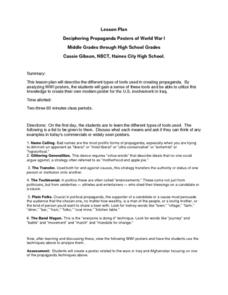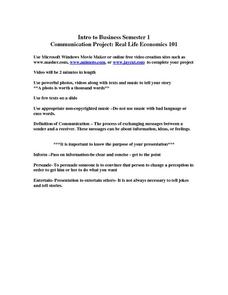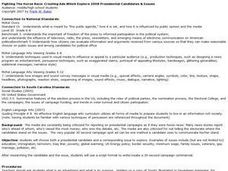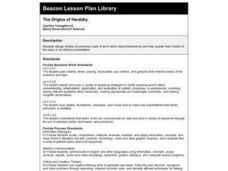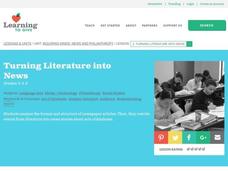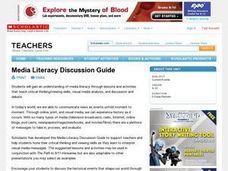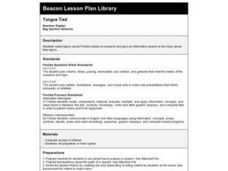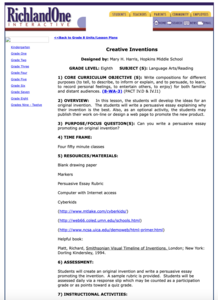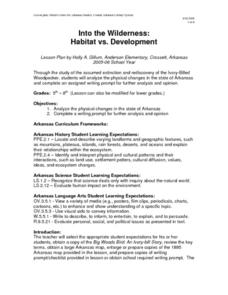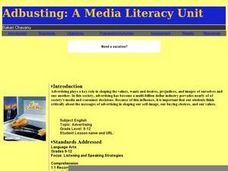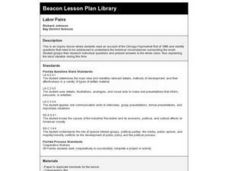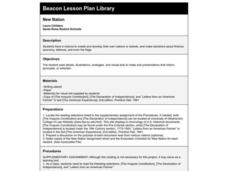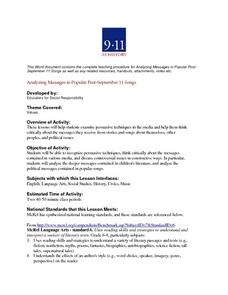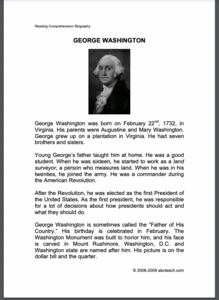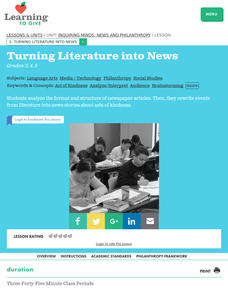Curated OER
Deciphering Propaganda Posters of World War I
What strategies are employed when creating propaganda? Your young historians will learn about six different techniques utilized in the construction of political propaganda, particularly in the advertisements of World War I. The...
Curated OER
Whose Side Are You On?
Students role play, persuading and staying neutral during arguments. In this viewpoint instructional activity, students examine the viewpoints of soldiers in the Spanish-American War and role play. After a discussion, some students try...
Sharp School
Real Life Economics 101
Your learners will take key economic concepts, such as identifying needs versus wants and the four factors of production, and design a video to explain their topic choice to the class. Rather than have one person in charge of dispensing...
Museum of the Moving Image
What Makes an Effective Ad?
As an introduction to a series of related resources that examine political advertising and commercials from 1952-2012, class members use the provided rubric to analyze and rate the effectiveness of the emotion, persuasion, factual...
Sharp School
Travel Brochure Project
Designing a travel brochure is a classic project that will help your class members develop a variety of skills, such as researching informational texts, designing creative visual products, and communicating what you have learned.
Curated OER
Fighting The Horse Race: Creating Ads Which Explore 2008 Presidential Candidates & Issues
What is advertising? What role does it plan in an election? Middle and high schoolers discuss advertising and its purpose by sifting through different magazines and discussing the products they find. Then they relate advertisements to...
Curated OER
The Origins of Heraldry
Students design a personal coat of arms which depicts themselves and explain their shields to the class in an informal presentation.
Curated OER
Inquiring Minds: News and Philanthropy
Students study newspaper articles and rewrite events from literature into news stories about kindness. For this news article lesson, students read sentences from newspaper articles and identify the purpose of the article. Students...
Curated OER
Media Literacy Discussion Guide
Students examine and analyze visual media and its messages critically. They determine whether specific media messages inform, entertain, or persuade and what factors influence the media. Using primary sources, they participate in peer...
Curated OER
Designing Visual Support For "The Greatest American" Speech
Students study several periods in American history, define the term "greatest American," and brainstorm possible criteria for selecting great Americans. They create a three to five minute persuasive speech along with visual aids to...
Curated OER
Tongue Tied
Fourth graders select topics about Florida Indians to research and give an informative speech to the class about their topics. The main focus' of this lesson plan are the research, and the speech that each student gives to the class.
Curated OER
Creative Inventions
Ninth graders develop ideas for an invention and write a persuasive essay explaining why their invention is best. In this invention essay lesson, 9th graders review persuasive essay writing. Students create a graphic web for an original...
Curated OER
Into the Wilderness: Habitat vs. Development
By studying the once-assumed extinction, then rediscovery of the Ivory-Billed Woodpecker, learners look at the physical changes that have occured in habitats throughout Arkansas. This outstanding lesson is chock full of terrific...
Curated OER
Adbusting: A Media Literacy Unit
Young scholars examine the ethical issues regarding the role of advertising in our society. They watch a series of ads, analyze the messages of the commercials, and in small groups create a counter-ad.
Curated OER
The Ides March On - Caesar Today
Students make connections between the rule and reign of Julius Caesar and the leaders of other countries. They then create a news show that communicates their understanding of four essential questions that are included in the lesson.
Curated OER
Carnival Celebrations: Masks and Vejigantes
Students explore Carnival. In this Puerto Rico Carnival lesson, students discover the history of the cultural celebration as well as the significance of the elaborate masks worn for the festivities. Students create their own Carnival masks.
Curated OER
The California Gold Rush:
Students complete an Internet treasure hunt designed to give them practice in using Internet resources.
Curated OER
Labor Pains
Fourth graders research the Chicago Haymarket Riot of 1886. They read an account of this incident and brainstorm further details they want to know. Groups of students research and present the answers to their questions.
Curated OER
New Nation
Fifth graders discuss leadership, citizenship, symbols for a nation, how to create peace after reading "The Iroquois Constitution," "The Declaration of Independence," and "Letters from An American Farmer." They create their own nations...
Curated OER
World Fair? A Global Classroom Unit On Economic Rights
Students explore economic rights of people. After listening to statements and songs by people such as John Lennon and Mahatma Ghandi, students examine the truths and values depicted by each person. Students participate in a simulation to...
Curated OER
Promotional Leaflet for a European Country
For this European Union studies worksheet, students follow guidelines to create a brochure to promote tourism to a European country of their choice.
Curated OER
911 As History
Students recognize persuasive techniques, think criticaly about the messages contained in various media, and discuss controversial issues in constructive ways. They analyze the deeper messages contained in children's literature, and...
Curated OER
George Washington: Reading Comprehension/Biography
For this George Washington reading comprehension worksheet, 4th graders will read a short (1 page) biography about Washington and answer 6 multiple choice questions.
Curated OER
Turning Literature into News
Pupils analyze the format and structure of various newspaper articles. Then, they rewrite events from literature into news stories about acts of kindness.
